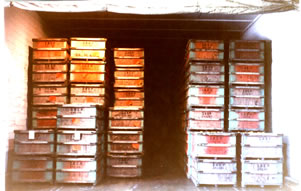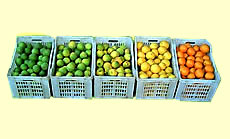Degreening of Florida Citrus

Degreening Room with Pallet Boxes Full of Fruit
So How Does the Degreening Process Work?
The fruit is brought in from the groves in large pallet boxes that hold the equivalent of 20 4/5 bu. cartons of fruit. The fruit is placed into large degreening rooms (pictured above) where the atmosphere that the fruit is subjected to can be closely monitored.
The temperature in the degreening rooms are maintained between 82 to 85 degrees and the relative humidity of the rooms are maintained between 90 to 95 percent. The rooms are ventilated so that the air in the rooms is changed once per hour. This is done to prevent the accumulation of carbon dioxide which is given off by the fruit. If carbon dioxide is allowed to accumulate, the effectiveness of the degreening process will be diminished and eventually stopped.
Once conditions in the rooms have stabilized, ethylene gas is introduced at a concentration of 5 parts per million and the conditions in the room are carefully monitored.
It can take approximately 72 hours to properly color pre-Thanksgiving Navels and Grapefruit. The coloring process toward the end of December can be reduced to 24 to 12 hours to achieve good color.

What exactly happens during the degreening process?
A technical explanation is that chlorophyllase enzymes break down green chlorophyll and unmask orange or yellow carotenoid pigments in the fruit. In other words, the ethylene gas helps to destroy the chlorophyll in the skin of the fruit and allows the yellow or orange peel to predominate.
Does the Degreening process cause the fruit to ripen?
Absolutely not. Citrus fruit is non-climacteric meaning that unlike tomatoes, pineapples or peaches it cannot ripen once it is separated from the tree. That is why all citrus fruit must be picked mature and why all citrus fruit ripens naturally.
Is ethylene a naturally occurring gas?
Yes many types of fruits and vegetables give off ethylene gas. If you search the internet you can find many retailers that sell bags and other storage containers that are designed to absorb the ethylene gas given off by fruits and vegetables so as to preserve your fruits and vegetables longer. One example that we found is the Ethylene Gas Guardian (which we do not endorse).
Can the degreening process cause any problems?
Since the degreening process is breaking down the chlorophyll in the skin of the fruit, the degreening process does have the adverse effect of shortening the shelf life of a piece of fruit. That is why we are very careful never to exceed the recommended degreening times established by industry wide agencies.
So what is the real timeline between when our fruit is harvested and when it is shipped to us?
In November it is as follows:
1 day to pick the fruit and haul it into the packing house (pick and haul)
3 days (72 hours) to degreen the fruit, and
1 day to process and pack the fruit and allow it time to cool.
In December it is as follows:
1 day to pick the fruit and haul it into the packing house (pick and haul)
1/2 to 1-1/2 days to degreen the fruit, and
1 day to process and pack the fruit and allow it time to cool.
(When fruit emerges from the wax machines it is warm as it has passed under dryers that will dry the wax that is placed on the fruit to preserve its freshness. The fruit should be allowed to cool so that it is not placed warm, directly into a trailer.)
Is it possilbe to run any Fall Crops "directly from the grove"?
Yes, when we get into the last weeks of December, certain crops such as tangelos will break color on the trees if we are fortunate and receive the right climatic conditions to encourage the coloring process...specifically cold weather. However the percentage of fall crops leaving the state that have not been subjected to the degreening process is very small.
Green is beautiful?
The degreening process is the largest bottleneck that we face in preparing fruit for shipment and can take up to three days in October and November. Acknowledging this, back in the 1980's Florida attempted to educate the consumer that a green piece of fruit that has met maturity is just as tasty and healthy as a mature orange or yellow piece of fruit. This was in hopes that the degreening process could eventually be eliminated. A campaign was started entitled "Green is Beautiful" hoping to make consumers aware that the color of the fruit is not an accurate indicator of its maturity.
Dispite all efforts, it seemed that consumers were just not going to settle for a green grapefruit or navel orange on their breakfast table. So we are still degreening.
References
If you would like to learn more about the subject of degreening citrus fruit please check out the following links:
Recommentations for Degreening Florida Fresh Citrus Fruits Univ of FL
Degreening methodology and citrus fruit physiology
Degreening and Citrus Fruit Quality - Univ of FL
